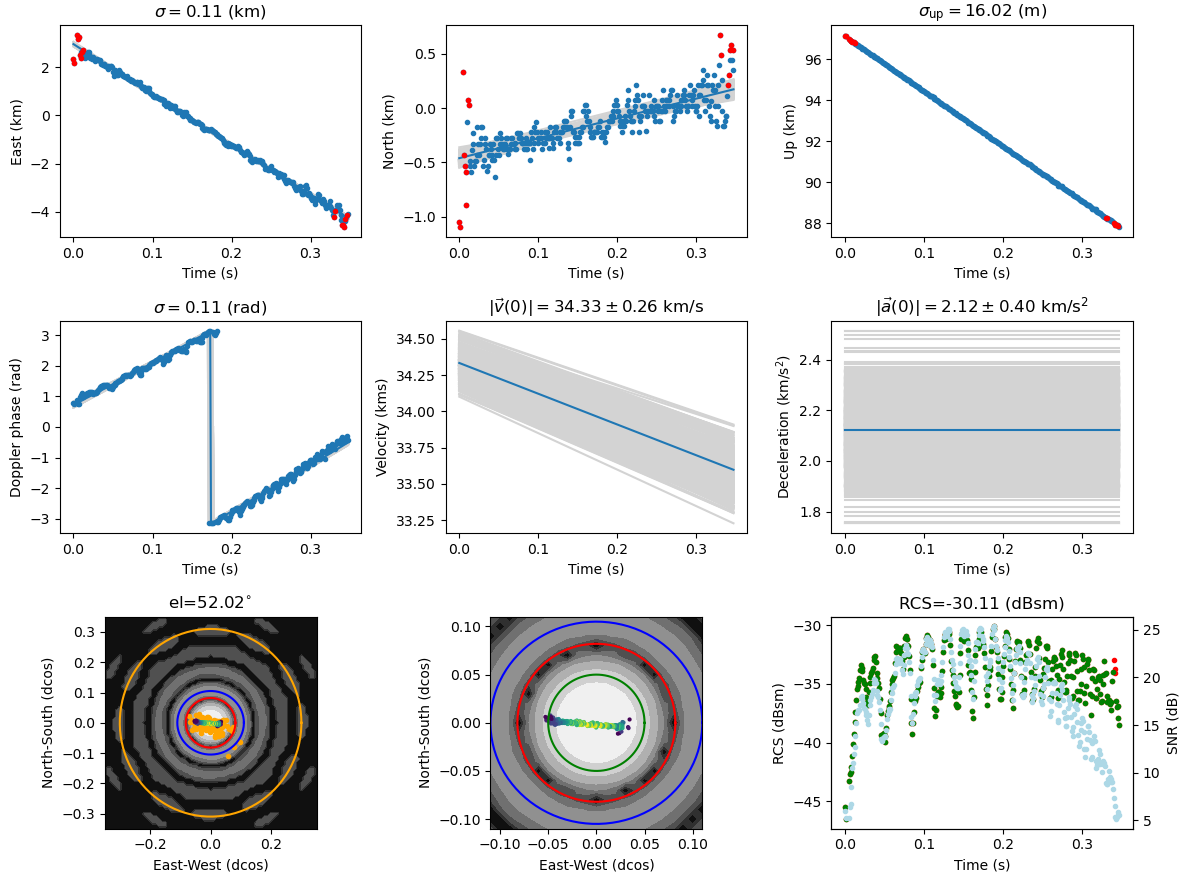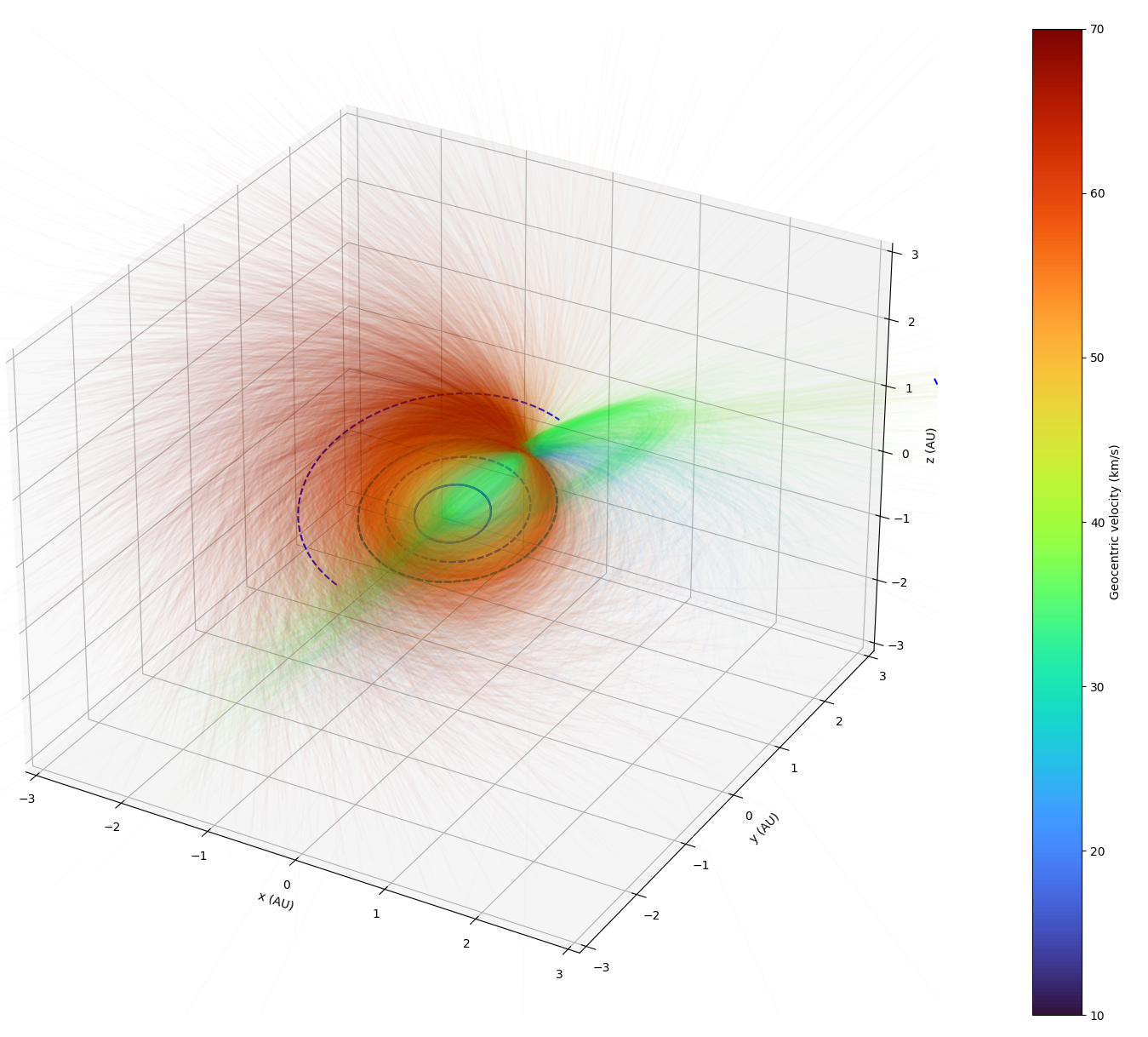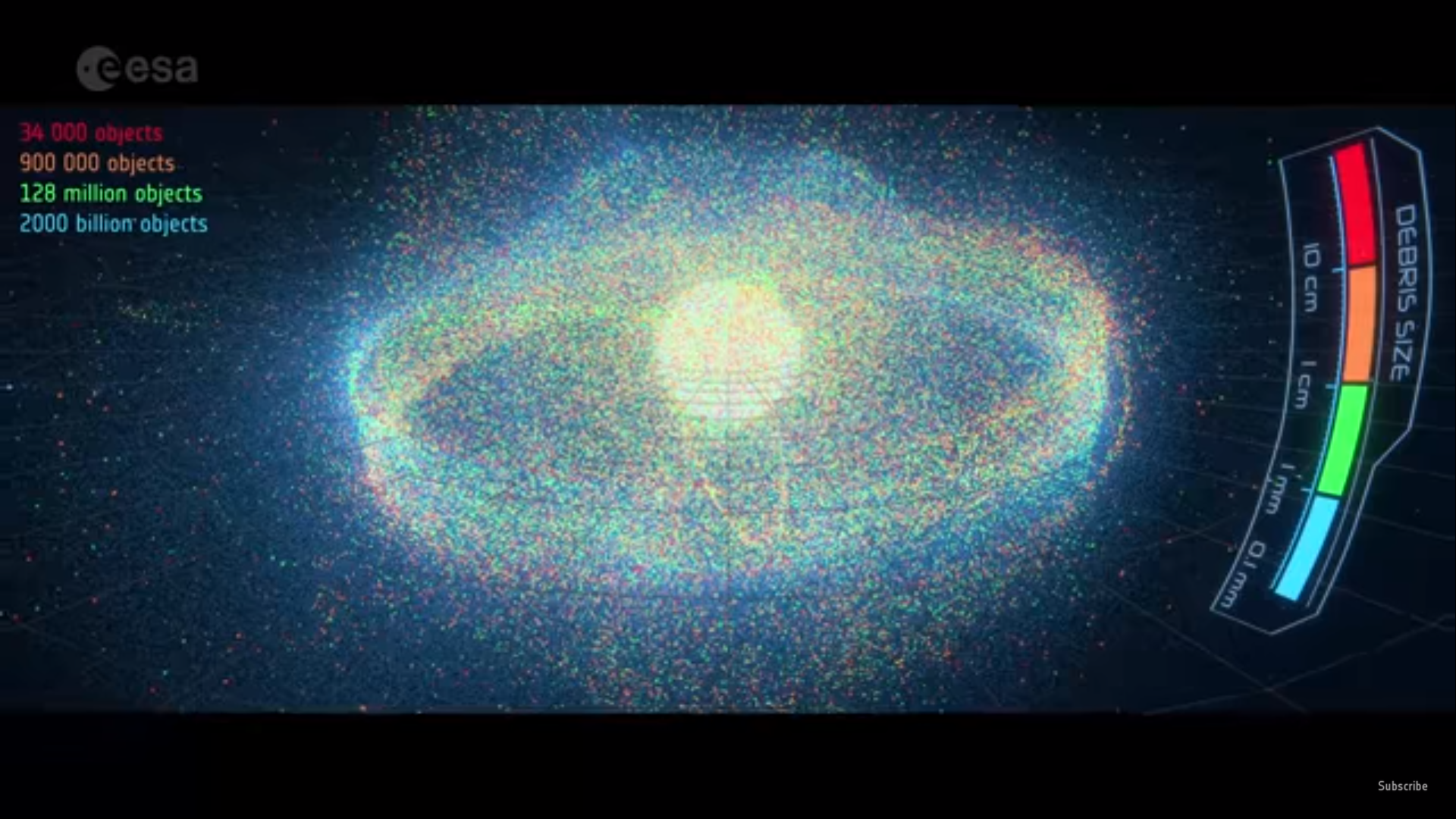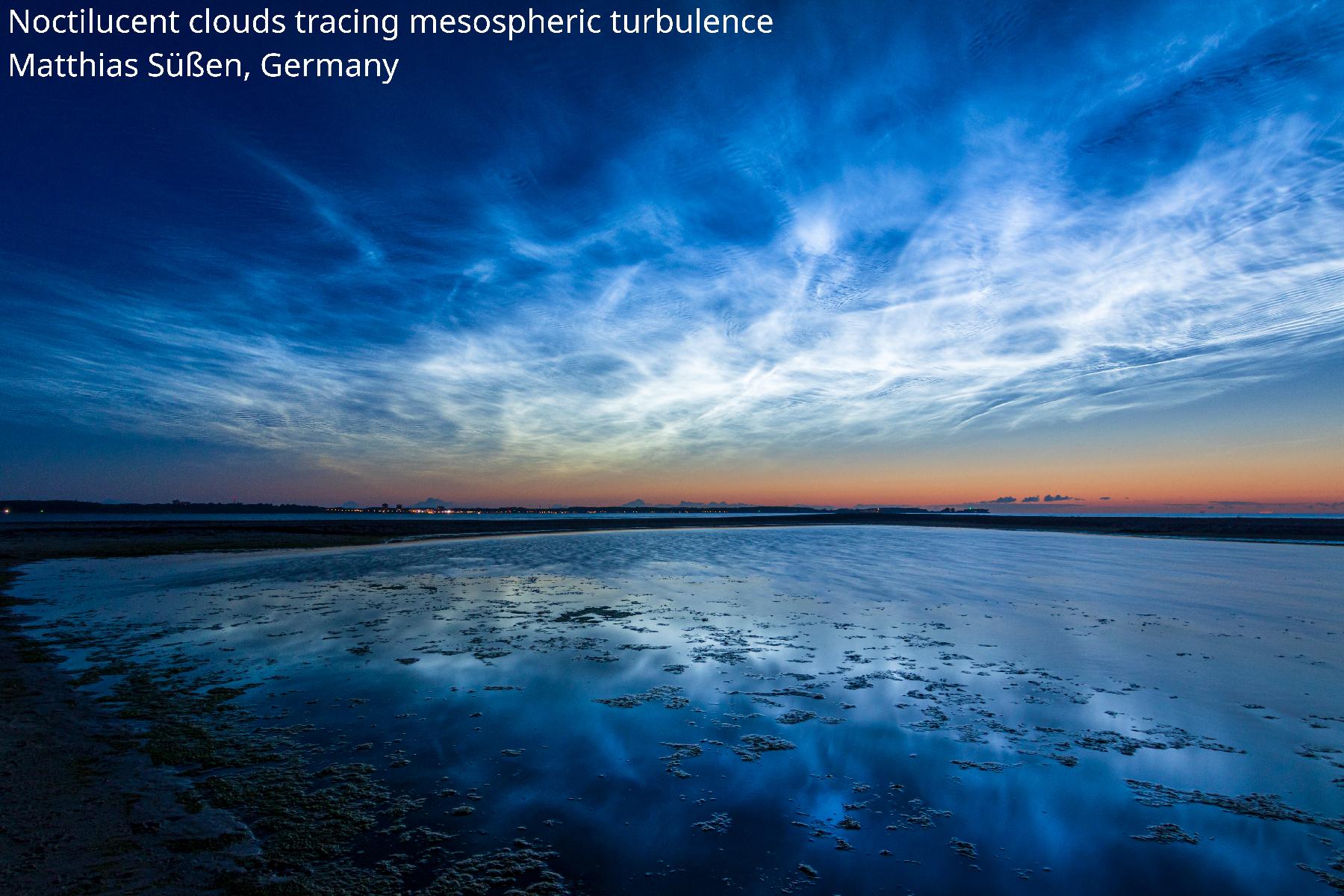Master Thesis Proposals
Presented here are thesis proposals for students, supervised by staff at the Space Physics group.
The scope of these proposals can be adjusted and are equally suitable for students from the 5-year integrated masters (30sp) and the 2-year master’s program in Physics (60sp)
The Space Physics group currently have the following project proposals:
- An automatic classification method of meteor head echoes
- A search for interstellar meteors
- A model of the Geminids meteoroid stream
- Aperture design of a dust collector instrument for a mosespheric rocket
- Arc discharges in a DC plasma
- Auroral Image Processing
- Estimating turbulent dissipation-rates in the MLT region using meteor
radar networks - Dust destruction during Coronal Mass Ejections
- Dust measurements with Solar Orbiter
- Dynamics of charged particles in planetary magnetospheres
- Measurement of three dimensional high resulution winds from PMSE echoes
- Meteors and meteor ablation
- Mission and sensor design for in-orbit radar for detecting space debris
- Model calculations of mesospheric clouds
- Simulation of magnetospheric plasma in a laboratory experiment
- Use of convolutional neural networks for automatic scaling of ionograms
- Wind velocities from PMSE echoes
An automatic classification method of meteor head echoes

Supervisor: Prof Juha Vierinen
Description:
Our knowledge of the influx of meteoric matter into the Earth's
atmosphere relies on radar observations of meteors. One of the highest
quality sources of radar measurements is obtained using high power
large aperture radars. These catalogues tell us about the influx of
meteors with Earth crossing orbits, with masses approximately 10^{-9}
kg and larger.
One important detail about observations of meteors is
fragmentation. It is important to know when meteors exhibit signatures
of fragmentation, as it affects our estimates of mass influx, as well
as how meteoric materials are deposited into the atmosphere. Another
important signature in meteor radar observations is differential
ablation. When meteors up in the atmosphere, materials with different
evaporation temperatures are expected to be depleted at different
altitudes. Many meteor head echoes show signatures of differential
ablation.
Your task is to develop techniques for identifying signatures of
fragmentation and differential ablation within the catalogue of meteor
observations, which currently contains about 300000 meteors. This
catalogue will in the future hold over 1 million meteors. It is
important that the automatic detection method is reliable and can be
used for large datasets. Machine learning techniques, such as
convolutional neural networks, or fully connected neural networks are
one possible solution.
In this project you will learn about: orbital meteoroids, ablation of
meteors, radars, programming, machine learning, data science, and statistics.
A search for interstellar meteors

Supervisor: Prof Juha Vierinen
Description:
Our knowledge of the influx of meteoric matter into the Earth's
atmosphere relies on radar observations of meteors. One of the highest
quality sources of radar measurements is obtained using high power
large aperture radars. These catalogues tell us about the influx of
meteors with Earth crossing orbits, with masses approximately 10^{-9}
kg and larger.
Most of the matter entering the Earth's atmopshere is within solar
system bound orbits, but some objects are thought to originate from
outside of our solar system. The interstellar flux is currently poorly
known, constrained by only a few extremely unreliable
observations. However, there have recently been observations of two
interstellar asteroids: Oumuamua and Comet Borisov. These are large
objects that have trajectories determined precisely using long
observation spans made with optical telescopes. And yet, there are no
reliable observations of interstellar micrometeoroids observed using
radars. Information about interstellar meteors is important for
estimating the density of matter in interstellar space, as well as for
modeling how matter mixes between different solar systems.
Your task is to determine orbits for the catalogue of meteor
observations, and search for candidate detections of interstellar
meteors. Even if no candidate detections are found, the project will
provide an extremely valuable upper bound for the flux of interstellar
meteors detectable with high power large aperture radars. The
catalogue currently contains about 300000 meteors. This catalogue will
in the future hold over 1 million meteors. It is important that care
is taken in estimating the uncertainty of orbital elements.
The project will rely on the Rebound numerical propagator, as well as
the existing catalogue of meteor trajectories determined using high
power large aperture radar observations. This task may also include a
visualization of meteor orbits determined using radar.
In this project you will learn about: orbital mechanics, meteoroids,
meteor streams, radars, programming, data science, and statistics.
A model of the Geminids meteoroid stream

Supervisor: Prof Juha Vierinen
Description:
Our knowledge of the influx of meteoric matter into the Earth's
atmosphere relies on radar observations of meteors. One of the highest
quality sources of radar measurements is obtained using high power
large aperture radars. These catalogues tell us about the influx of
meteors with Earth crossing orbits, with masses approximately 10^{-9}
kg and larger.
Most of the matter entering the Earth's atmopshere is within solar
system bound orbits and it comes from the sporadic meteor complex,
i.e., meteoroids that are so old that they can no longer be reliably
associated with any parent body. In addition to the sporadic meteor
complex, there are meteor showers, which can be associated with
specific parent bodies, as the fragmentation or shedding of meteoric
matter has occurred relatively recently. One of the most important
meteor showers is the Geminids, which extends from November through
December, peaking on December 12th each year. This meteor shower is
thought to be fairly recent, and its parent body is 3200 Phaethon. The
age of the stream is estimated to be several tens of thousands of
years old. The Japanese space agency (JAXA) will soon launch a mission
called DESTINY+ to study the Gemininds meteor stream by making a close
fly-by of 3200 Phaeton.
There are still many unknown details when it comes to the Geminids
meteor shower. There is no consensus on how the stream of meteors
associated with the Gemininds was created. A commonly proposed model
is that there was a catastrophic collision that happened relatively
recently, creating the stream of meteoroids.
Your task is to use the catalogue of radar meteor observations to
create a model of the Geminids meteor stream. This will include
meteoroid size and orbital elements, which can be inferred from the
observations. You task will be to infer the density function of
meteoroids based on radar observations. Challenges include modeling
radar detectability, as well as the blurring of the estimated density
function due to observation uncertainties.
The resulting study will be by far the most comprehensive meteor head
echo study of the Geminids made to date, and it will serve as a basis
for many future modeling efforts, as well as space missions.
The project will rely on the Rebound numerical propagator, as well as
the existing catalogue of meteor trajectories determined using high
power large aperture radar observations. This task may also include a
visualization of meteor orbits determined using radar.
In this project you will learn about: orbital mechanics, meteoroids,
meteor streams, radars, programming, data science, and statistics.
Use of convolutional neural networks for automatic scaling of ionograms

Supervisor: Prof Juha Vierinen, Dr Andreas Kvammen, Dr. Devin
Huyghebaert
Description:
Millions of ionograms are acquired annually to monitor the
ionosphere. The accumulated data contain untapped information from a
range of locations, multiple solar cycles, and various geomagnetic
conditions. In this study, you will apply convolutional neural
networks to automatically classify and scale high-latitude
ionograms. A supervised approach is implemented and the networks are
trained and tested using manually analyzed oblique ionograms acquired
at a receiver station located in Skibotn (Kvammen et.al., 2024). You
will extend the algorithm to also work at three other locations:
Kuusamo, Oulu, and Ivalo. The classification routine categorizes the
observations based on the presence or absence of E− and F-region
traces, while the scaling procedure automatically defines the E− and
F-region virtual distances and maximum plasma frequencies.
Oblique ionograms can be used to study the horizontal structure of the
ionosphere by measuring the electron density at reflection height with
great precision. This allows e.g., measuring the horizontal
wavelengths and phase velocities of thermospheric gravity waves. The outcome of the study can also be used to study how auroral precipitation affects radio communications by comparing the ionogram measurements with optical images of aurora, as shown in the Figure above. This includes formation of plasma turbulence on the outskirts of auroral arcs, as well as HF telecommunications blackouts.
In this project you will learn about: ionospheric radio propagation, auroral phenomena,
machine learning, programming, radars, data science, and about ionospheric phycics.
Kvammen, A., Vierinen, J., Huyghebaert, D., Rexer, T., Gustavsson, B.,
Floberg, J., & Spicher, A. (2024). NOIRE-Net-A convolutional neural
network for automatic classification and scaling of high-latitude
ionograms. Frontiers in Astronomy and Space Sciences, 11, 1289840.
Mission and sensor design for in-orbit radar for detecting space debris

Supervisor: Prof Juha Vierinen
Description:
The rapidly increasing density of man-made orbital debris in Earth's
orbit poses a risk for spaceflight. The density of objects larger than
about 1 cm can be estimated using measurements made with powerful
ground based radars, and objects much smaller than 1 mm can be
characterized by crater counting of space flown materials such as
solar panels. No method for measuring mm-scale objects exists, and
hence not much is known about the density of these objects. It has
been proposed that using a mm-wavelength radar in Earth orbit could be
used to detect and estimate the density of space objects. This relies
on the fact that radar echo power is proportional to 1/R^4, where R is
the distance between radar and the object. By bringing a radar to 1 km
distance from an object instead of a 1000 km distance will increase
the returned radar echo power by a factor of 10^12.
Your task will be to use the NASA ORDEM model to estimate the flux of
space debris measured using a radar on a satellite. You will also be
in charge of optimizing this sensor for maximizing detection
count. This will involve determining e.g., how the antenna size,
antenna orientation, radar transmit power, satellite orbit, and signal
processing details affect the rate of space debris detections.
The results of your thesis work will be used in the planning and implementation of the Norwegian Research Council funded QBDebris project (Ellingsen et.al., 2023), which aims to build and fly two cubesats with radars that are used to detect space debris.
In this project you will learn about: space mission planning, radars,
modeling of space debris, and programming.
For more information about the QBDebris satellite mission: https://en.uit.no/project/qbdebris
Estimating turbulent dissipation-rates in the MLT region using meteor
radar networks

Supervisor: Prof Juha Vierinen
Description:
Stratified turbulence (ST) has been proposed as a model for the
dynamics of the mesosphere‐ lower thermosphere (MLT) region. This
theory postulates that for horizontal mesoscales (∼1–400 km), the
kinetic energy of horizontal winds dissipates from large to small
scales with an approximately mean constant rate. A recently developed
method (Vierinen et.al., 2024) allows measuring the temporal and
spatial variability of this rate of dissipation using meteor radar
networks. This information is important for our knowledge of the
energy balance of the mesosphere lower thermosphere region, especially
when it comes to heating due to cascade of large scale atmospheric
motions to smaller scale atmospheric motions.
In this project, you will utilize a long term data-set from Germany to
study the annual variability and long term evolution of the turbulent
dissipation rate. A preliminary pre-study has already been conducted
to demonstrate the feasibility of the project.
What you will learn: theories of turbulence, meteor radars,
programming, statistical inverse problems, data science.
Vierinen, J., Poblet, F.L., Chau, J.L., Avsarkisov, V., Pécseli, H.L.,
Tsutsumi, M., Nozawa, S., Johnsen, M.G., Latteck, R. and Gulbrandsen,
N., 2024. Dissipation rates of mesospheric stratified turbulence from
multistatic meteor‐radar observations. Geophysical Research Letters,
51(11), p.e2023GL105751.
Aperture design of a dust collector instrument for a mosespheric rocket
Supervisor: Ingrid Mann
Required course: contact supervisor
Recommended courses: FYS-1002, FYS-2009, FYS-2019
Description:
To bring dust particles from the mesosphere back to Earth for laboratory studies, collector instruments can be flown during rocket flights with payload recovery. This project is related to the sample collector instrument MESS which is currently in development stage. To facilitate that collected samples are not contaminated by other particles, the sample collector needs to have an aperture that opens and closes during the rocket flight and that is tightly closed otherwise under severe conditions of launch, re-entry and recovery. The goal of this project is to develop on test level the aperture mechanism and the electronic control of the motors for opening and closure. Aside from the launch conditions, the design also needs to be suitable for the required cleanliness and handling of samples. This work is linked to a project on dust in the mesosphere that it funded by RCN.
This project is interesting for students who like more technically oriented work.
Auroral Image Processing
Supervisor: Patrick Guio, patrick.guio@uit.no
Overview:
VOronoi Image SEgmentation (VOISE), described inGuio, P. and Achilleos, N.(2009) is adynamic and self-organising algorithm to create a partition of an image into Voronoi cells ac-cording to a prescribed cost function, presently a homogeneity criterion.
The VOISE algorithm was developed to provide an automated and objective method tocharacterise auroral emissions (mean intensity, spatial extent, length scale) observed at Saturnand Jupiter. For instance ultraviolet (UV) images collected by the Hubble Space Telescope, butalso infrared (IR) images collected by ground-based telescopes at Mauna Kea, Hawaii.
Scientific Aims:
The aim is to develop an efficient and versatile image processing around VOISE that can beused on a variety of research studies based on auroral imaging, but also explore the possibil-ities in other ‘big-data’ domains, such as medical imaging and Earth observation. The graphdata generated by VOISE could potentially be used for further processing via machine learningalgorithms, such as clustering.Planetary auroral / particle-dynamics mapping studies are particularly timely with currentand future missions to Jupiter, NASA Juno and ESA Juice, as well as the successful missionto Saturn, Cassini. Auroral imaging processing is also a relevant topic to the field of spaceweather.
Work Summary:
The project is suitable for a one-year Master’s project (60 STP) in Physics or a five-year In-tegrated Master’s project (30 STP + 10 STP preparatory project), and several strands for theproject are available
• Develop 2D/3D tools within VOISE for image pre- and post-processing, as well as datavisualisation.
• Design a versatile, extensible implementation of VOISE where new cost functions caneasily be ‘plugged in’.
• Explore applications to other ‘big-data’ domains, such as medical imaging, Earth obser-vation.
Pre-requisites:This project would suit a student with an interest for mathematical / computational modellingand programming. The available code is written in Matlab and C++, so experience with theselanguages and similar languages is an advantage.
Dust destruction during Coronal Mass Ejections
Supervisor: Ingrid Mann
Required course: contact supervisor
Description:
Coronal mass ejections (CME) are strong outbursts of mass from the solar corona into interplanetary space. These frequently occurring events are characterized by a temporal increase of the solar wind density and by a large number of heavy ions. When high-energy ions hit a solid they remove atoms out of the solid. This process, called sputtering leads to surface erosion at small solar system objects that are exposed to the solar wind. Sputtering removes atoms from dust particles and can fully destroy them. Our ongoing study showsthat the sputtering rates increase by about two orders of magnitude during CME in comparison to quite solar wind conditions. The goal of this project is to investigate the time variation of the dust destruction caused by CME and to investigate whether the near solar dust cloud can disappear during periods of high solar activity with strong CME. This work is linked to a project on dust in the heliosphere that is funded by RCN.
Dust measurements with Solar Orbiter
Supervisor: Ingrid Mann
Required course: contact supervisor
Description:
The interplanetary medium between the planets contains small dust particles that are fragments from comets and asteroids. When these particles impact onto a spacecraft they generate small fragments, ions and electrons. The generated free charges change for short time the electric potential of the spacecraft which usually is determined by solar wind and solar photon fluxes. In this way, dust impacts influence antenna measurements made from the spacecraft and dust fluxes can be inferred from the antenna measurements. In February 2020, the European Space Agency (ESA) launched the Solar Orbiter spacecraft. Solar Orbiter orbits the Sun in an elliptic trajectory that crosses the orbits of Venus and Mercury and passes regions of high dust density. While Solar Orbiter moves initially in the ecliptic, i.e. the same plane as the orbits of the planets, the spacecraft will gradually move out of the eclipticand encounter unexplored solar wind conditions and dust fluxes. The goal of this project is to study the conditions of the dust impacts onto the spacecraft along its trajectory and to simulate the dust fluxes onto the spacecraft based on model assumptions and observational data. This work is linked to a project on dust in the heliosphere that it funded by RCN.
Dynamics of charged particles in planetary magnetospheres
Supervisor: Patrick Guio, patrick.guio@uit.no
Overview:
The Earth’s magnetic field is to a good approximation dipolar, and magnetospheric chargedparticles, depending on their kinetic energy, pitch angle and equatorial distance, can remaintrapped in this field with their motion characterised by an azimuthal drift, a meridional bouncemotion and gyration motion around the field line (see for instance ̈Ozt ̈urk(2012). High-energyelectrons and protons in the van Allen radiation belts are such examples.At the gas giant planets Jupiter and Saturn, the magnetic field deviates from a dipole dueto the internal source of plasma provided by their moons, Io and Enceladus resp. and the fastplanetary rotation period (∼10 h), developing into a disk-like structure at the equator wherecentrifugal force is largest. This structure is often referred to as a magnetodisc.
Scientific Aims:
The aim of this project is to investigate and characterise deviations of the dynamics of chargedparticle trapped in a magnetodisc magnetic field compared to a pure dipole magnetic field usingnumerical modelling, and possibly analytic calculation. The numerical modelling will build onthe existing University College London (UCL) Magnetodisc Model and other existing code forcharged particle motion tracing.This project is particularly timely with the current and future missions to Jupiter, Juno andJuice, as well as the successful mission to Saturn, Cassini. The physics of trapped particles inmagnetospheres is also a relevant topic to the emerging field of space weather.
Work Summary:
The project is suitable for a one-year Master’s project (60 STP) in Physics or a five-year In-tegrated Master’s project (30 STP + 10 STP preparatory project), and several strands of theprojects are available
• Include the effect of centrifugal force in the so-called guiding centre approximation.
• Validate the guiding centre approximation calculations with direct particle tracing.• Compare the dynamics of charged particle at Saturn and Jupiter.
• Investigate the effects of the solar wind and internal conditions at the gas giants on thedynamics of trapped particles.
Measurement of three dimensional high resulution winds from PMSE echoes
Supervisor: Ingrid Mann
Required course: contact supervisor
Description:
Polar Mesospheric Summer Echoes (PMSEs) are intense scattering of VHF radar signals resulting from formation of ice particles in the summer polar upper mesosphere. Tristatic EISCAT radar observations are made at 224 MHz during summertime. The radar transmitter and receiver are located at Tromsø, Norway and two other receiving stations are at Kiruna, Sweden and Sodankyla, Finland. Using the Doppler shifts of the common volume PMSE echoes as tracers, the three dimensional winds may be estimated with high temporal resolution. The goal of the work is to estimate the winds and validate it with the help of wind estimations by other techniques. This work is linked to a project on dust in the mesosphere that it funded by RCN.
Meteors and meteor ablation
Supervisor: Ingrid Mann
Required courses: contact supervisor
Description:
Cosmic dust particles are heated and vaporize when they enter the Earth’s atmosphere. This leads to the formation of meteors and the process is called ablation. Ablation rates depend on the entrance velocity of the dust as well as on its size and composition. Meteors typically occur at altitudes between 70 and 110 km. They are the source of dust particles in the mesosphere, the region of the atmosphere at altitudes around roughly 50 – 95 km. The ablation generates layers of heavy atoms in the mesosphere that are the seed of newly forming mesospheric dust. Some dust particles survive the entry, so that also unaltered cosmic dust exists in the mesosphere. The goal of this project is to study the entry conditions of the cosmic dust in order to estimate the number of heavy ions that the dust generates and the amount of remaining dust particles. The results will be used to investigate the composition and variability of dust and heavy ion layers in the mesosphere. This work is linked to a project on mesospheric dust that it funded by RCN.
Model calculations of mesospheric clouds
Supervisors: Ingrid Mann and Rune Graversen
Required courses: Contact supervisor
Description:
Cosmic dust and meteoroids and their fragments play an important role in the physical and chemical processes of the upper atmosphere. Cosmic dust particles that enter the atmosphere are heated, producing evaporated material that dissociates and ionizes at about 140–60 km altitude. Small meteoroids and dust particles, gaseous species that originate from the meteoroids, and small meteoritic smoke particles re-condense and are a core for ice condensation which leads to the formation of mesospheric clouds. The observed shape of the clouds indicates the transport of the particles in the atmosphere. At UiT we have observational data related to mesospheric clouds from in-situ rocket observations and from radar observations. We also collaborate with a group that carries out optical observations.
The WACCM-CARMA from the US National Center for Atmospheric Research is an atmospheric high-altitude model, Whole Atmosphere Community Climate Model (WACCM), coupled with anaerosol microphysical model (CARMA). This project aims to use output from the WACCM-CARMA model for studying the particle transport in mesospheric clouds, the shape of these clouds, and to compare with observations. Given that the model can reproduce observed aspects of the mesospheric clouds, the model can be used to investigate the physics governing these clouds.This work is linked to the RCN funded projects on mesospheric dust and on Arctic climate,
Wind velocities from PMSE echoes
Supervisor: Ingrid Mann
Required course: contact supervisor
Recommended courses: FYS-1002, FYS-2009, FYS-2019
Description:
Polar Mesospheric Summer Echoes (PMSEs) are intense scattering of VHF radar signals resulting from formation of ice particles in the summer polar upper mesosphere. Tristatic EISCAT radar observations are made at 224 MHz during summertime. The radar transmitter and receiver are located at Tromsø, Norway and two other receiving stations are at Kiruna, Sweden and Sodankyla, Finland. Using the Doppler shifts of the common volume PMSE echoes as tracers, the three dimensional winds may be estimated with high temporal resolution. The goal of the work is to estimate the winds and validate it with the help of wind estimations by other techniques. There is also an opportunity to define other topics on PMSE studies for interested students. This work is linked to a project on dust in the mesosphere that it funded by RCN.
This topic is interesting for students who are interested in working with observational data and for students who are interested in theoretical studies. The focus can be adjusted according to the interest of the student.